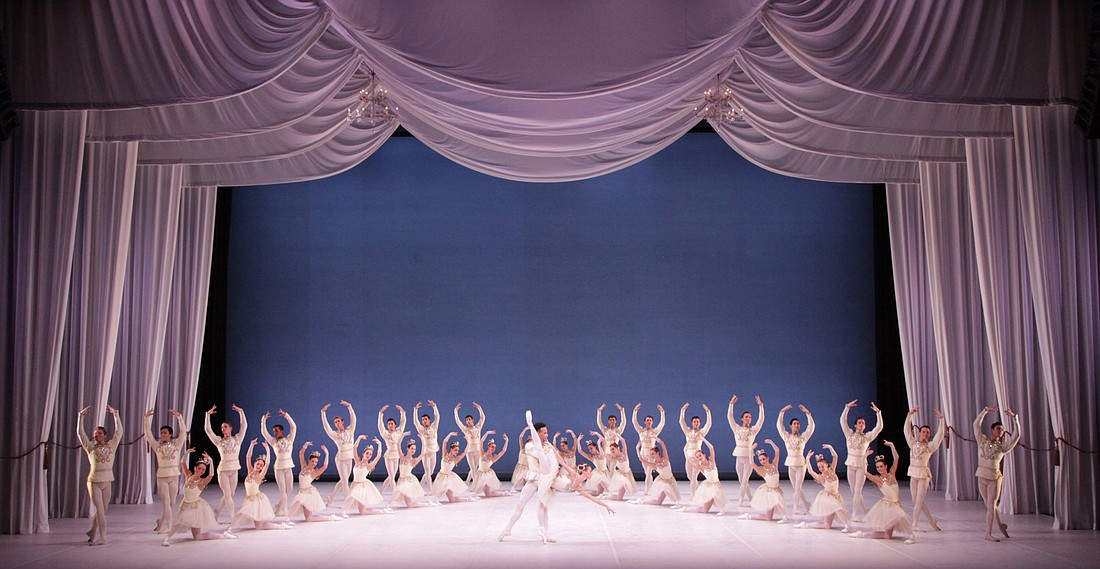- May 5, 2025
-
-
Loading

Loading

Picture 34 Sarasota Ballet company members onstage at the same time.
They’re dressed in identical all white, glimmering costumes, creating the same graceful, jewelry box ballerina lines every aspiring dancer dreams of re-creating.
The piece is George Balanchine’s “Diamonds,” of course, and it’s one of the three ballets on the company’s latest program, “Victorian Winters.”
“It’s breathtaking,” says Assistant Director and Repetiteur Margaret Barbieri with a dreamy look in her eyes.
“Everything has to be the same,” adds Principal Dancer Katelyn May. “Every pinky has to be the same height and heads all the same direction — and I think we’ve all been so eager to want that for each other that we’re all constantly checking in and helping each other.”
It’s absolutely a team effort. For those like May who are learning the piece for the first time, it takes a great deal of effort to not only memorize the choreography but execute it in perfect synchronization with the other dancers.
Victoria Hulland, a fellow principal dancer, says any new piece requires hours of work outside the studio. Whenever she learns a new ballet, she gets home from rehearsal, puts the music on and goes back to practicing.
“You don’t want to come in the next day not knowing what you’re doing,” she says with a knowing look.
Barbieri nods her head, adding that constantly working on new pieces, even when home alone, is the only way to commit them to memory — mentally and physically. There’s great power in muscle memory.
But May doesn’t mind the extra work. In fact, she embraces it.
“When something is that special you want to go home and do your homework and come in the next day and build on what was taught before,” she says. “So by the time you get on stage you can do the people who originated these roles justice.”
Being prepared also helps her feel more relaxed and in the moment, she adds. When she’s not worrying about forgetting the movements, she can enjoy herself and take pride in bringing an iconic piece to life.
Rehearsing such a massive work is difficult for Barbieri because she has to watch so many people at once. She often splits them into groups so she doesn’t miss any potential corrections that need to be made.
“One side of the stage could be doing rubbish while you’re watching the other,” she says with a laugh.
But why is it so important to get “Diamonds” right?
“‘Diamonds’ recalls the order and grandeur of imperial Russia and the Mariinsky Theatre, where Balanchine was trained,” says The George Balanchine Trust website. “Mary Clarke and Clement Crisp have written: ‘If the entire imperial Russian inheritance of ballet were lost, ‘Diamonds’ would still tell us of its essence.’”
When most people think of ballet, they’re probably thinking of snippets they’ve seen and/or heard from the great ballets set to the music of composer Peter Ilyitch Tchaikovsky — “Swan Lake,” “The Nutcracker” and “The Sleeping Beauty.”
“Jewels,” the three-part collection of ballets for which “Diamonds” (the “jewel of the jewels,” as Barbieri calls it) is the finale, is not as recognizable to those outside ballet. But compared to the aforementioned, the legacy this Tchaikovsky-backed, plotless ballet has had on the dance form is much more profound.
But then again, so is the impact of Sir Frederick Ashton’s “Enigma Variations,” another ballet on the “Victorian Winters” program that was included because of its reputation as one of the choreographer’s greatest ballets and because this year marks its 50th anniversary.
The Sarasota Ballet is also the only company outside of The Royal Ballet family to have performed it.
“Enigma” is set to the score of composer Edward Elgar, who wrote the suite as a sort of musical memoir. All the roles are actual people from Elgar’s life, and set in a house resembling his Worcestershire home, it carries a different kind of raw emotion, requiring more storytelling than other ballets the company dances.
Hulland will be dancing the roles of Lady Elgar and Isobel for the second time, and she says she looks forward to focusing more on character development this time around.
“I try to go more in depth … you already feel more comfortable with the choreography so you can focus on the artistry,” she says.
For May, it’s the opposite. She’s new to this ballet, so she’s thankful for fellow dancers like Hulland whose brains she can pick for advice on building her characters of Dorabella and Winifred.
Both “Diamonds” and “Enigma” were taught and rehearsed in September when their stagers were available, and even though it seemed too early at the time, Barbieri says she’s thankful the dancers committed those works to memory before the whirlwind of fall season began.
Speaking of — why stage these three as the winter program?
The first of the three ballets, Ashton’s “Les Patineurs,” is set at a Victorian skating party on a frozen pond. “Diamonds” has a winter feel with its grand white costumes. And “Enigma” is set in autumn as the cold is kicking in.
But why not that other ballet that’s so popular this time of year?
“We don’t like doing ‘Nutcracker’ every year,” Barbieri says. “We wanted to do something different … but a program everyone in the family can (still) enjoy.”